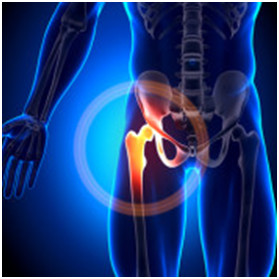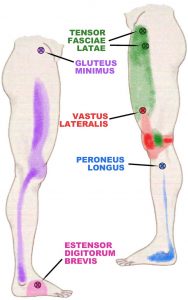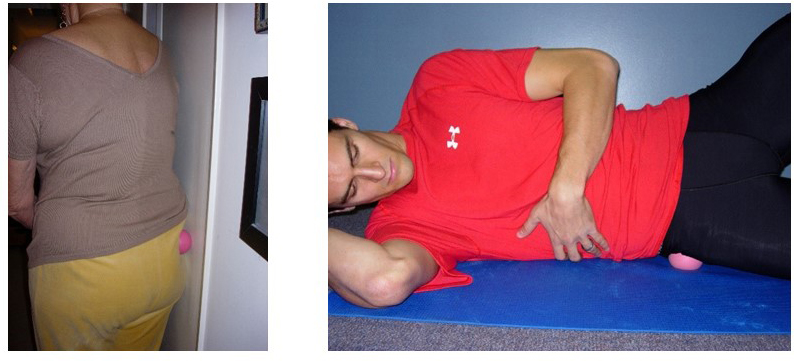A Common Cause For Pains From Hip To Knee
Author: Julie Donnelly, LMT –The Pain Relief Expert
Editor: Dr. Steve Chaney
Spring Is In The Air
 I remember as a child we sang “Though April showers may come your way…they bring the flowers that bloom in May…”
I remember as a child we sang “Though April showers may come your way…they bring the flowers that bloom in May…”
Of course, here in Florida we are blessed with flowers all year, but there is still a lovely feeling that happens in Spring. It’s still cool enough most days to go out running, and the humidity is still low.
Traffic will soon be easing up as our friends from the north start their trek back home, and daylight savings time is giving us more time to get to the beach for sunset. Lovely!
Fun Facts About Spring….
- The earliest known use of the term “spring cleaning” was in 1857
- The word “spring” has been used for the season since the 16th century
- The first day of spring is called the vernal equinox
- On the first day of spring, the sunrise and sunset are about 12 hours apart everywhere on earth
- Spring fever isn’t just a saying. Experts say the body changes due to the temperature and can cause an upset in your health.
- The actual start of spring varies from March 19th to the 21st, but it is commonly celebrated on the 21st.
Do you like to garden? Now is the perfect time to get your gardens planted so you’ll have home grown veggies for the entire summer. For me, it’s also a great time to do some spring cleaning and get the house in order before the summer closes all the windows and the air conditioning becomes our indoor relief.
But these activities can also cause a strain on muscles, so don’t forget to take care of yourself.
A Common Cause For Pains From Hip To Knee
 There are times when I am led to sharing a treatment because I had a run of clients all suffering from the same source muscle. That is what happened for this newsletter. In March I had at least six clients come to my office, all having different symptoms, but all stemming from the same source.
There are times when I am led to sharing a treatment because I had a run of clients all suffering from the same source muscle. That is what happened for this newsletter. In March I had at least six clients come to my office, all having different symptoms, but all stemming from the same source.
My clients complained of hip pain, thigh pain, knee pain, and pain down the outside of the lower leg.
In this case it was the Tensor Fascia Lata and two of the three Gluteal muscles: Medius, Minimus. The Gluteus Medius is directly over the Gluteus Minimus, so treating one will actually treat both. And the Tensor Fascia Lata is right next to both these muscles.
All these muscles insert into the same area of the hip, and for different reasons, they all cause hip pain. Also, each muscle refers pain to a different location, so you think you have a problem in these referred pain locations, but they are all coming from your hip.
This is one of the many times when working on one area will solve many different problems.
 Take a look at these Trigger Point charts:
Take a look at these Trigger Point charts:
To read the charts, look at the shaded area (which shows where pain is felt) and look for the muscle name in the same color. Then follow the arrow to the same-colored round circles with “x”. This is the trigger point (spasm) that is the source of that pain pattern.
You’ll notice that the spasm (trigger point) for the purple pain pattern is in the Gluteus Minimus at the outside of the hip, but the pain pattern goes to the outside of the thigh, the knee, and all the way down to the ankle.
The spasms for the Tensor Fascia Lata is in the same place on the hip, but the pain pattern is the hip, the thigh, and the outside of the knee.
In each of these cases the pain is being felt along the insertion points for the muscles.
Hip And Knee Pain Relief
To relieve the muscle spasms that are causing the problem, use my “Perfect Ball” (You can use a baseball or tennis ball, but my Perfect Ball is just the right size and hardness for the job). Then, either lie on the floor or stand up and lean into a wall as shown in the two photos below. Lean into the ball, easing your pressure onto the ball gradually. As the muscle releases it will hurt less and less.
 Then you can rotate your body, so the ball is pressing into the front of your hip or rotating so the ball is rolling toward the back of your body. You will likely find multiple painful tender spots. Each spot is a spasm that is
Then you can rotate your body, so the ball is pressing into the front of your hip or rotating so the ball is rolling toward the back of your body. You will likely find multiple painful tender spots. Each spot is a spasm that is  putting pressure on your bones or is pulling on the tendon (called the IlioTibial Band – ITB) that is putting pressure onto your lateral knee joint.
putting pressure on your bones or is pulling on the tendon (called the IlioTibial Band – ITB) that is putting pressure onto your lateral knee joint.
You can also treat these muscles by using a length of 1” PVC pipe as shown in the picture on the left.
This picture was shared with me by an athlete. An avid runner, she couldn’t get down on the ground, nor was there a wall that she could press into, but using the pipe and a street sign pole, she was still able to release the tight muscles that were preventing her from running.
This may not be perfect for you, but if you are an athlete, it could be just what you need when you’re unable to treat yourself as shown above.
You REALLY CAN Treat Yourself
Since 1989 I have been working with people who are experiencing severe &/or chronic pain. During those years I’ve managed to figure out why they are in pain, and how they can stop the pain by treating themselves.
It is wonderful when someone can come into my office and I can work directly with them, but I’ve found that the key is the self-treatments I teach them to do at home. With the self-treatments you can release the tension multiple times every day, retraining your muscles to stay relaxed.
Thousands of people have been able to stop pain fast because they have followed the simple techniques I teach.
You can stop pain fast too! Even chronic pain releases when you treat the source and not just the symptom!
To enable you to know where to treat, and how to treat the muscles that cause pain, I’ve produced several “How To” books and DVD programs.
Visit my shopping cart to see the full line of pain-relief products that will help you overcome:
- Shoulder pain
- Neck pain
- Carpal tunnel symptoms
- Trigger finger
- Low back pain
- Hip pain
- Sciatica
- Knee Pain
- Plantar Fasciitis
In fact, you can get relief for pains from your head to your feet!
Next Month’s Topic
In May I’ll be sharing about the muscles that cause the #1 repetitive strain injury in the entire world!
If you have, or know someone who has, low back pain, you won’t want to miss next month’s article.
Wishing you well,
Julie Donnelly
These statements have not been evaluated by the Food and Drug Administration. This information is not intended to diagnose, treat, cure or prevent any disease.
